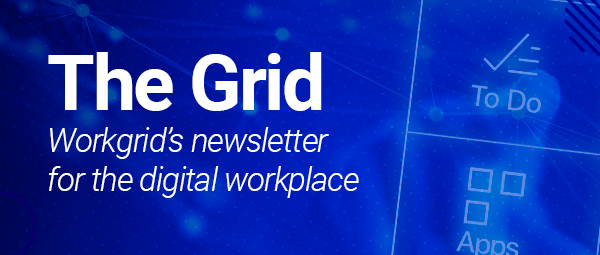Adapting your digital workplace
In a recent CIO chat on Twitter, Dion Hinchcliffe, expert in information technology, business strategy, and all-around future of work guru, got a question that’s likely on a lot of minds in one form or another these days…
How will organizations change over the next two years?
Completely valid. It’s impossible not to wonder what will come next. A lot of changes have already taken place, upending the very nature of work and forever altering the importance of the physical workplace for both organizations and employees alike.
Dion of course has his finger on the pulse of what CIOs are thinking given his dealings with companies of all types, and had a good response that covered a wide range of targeted and overarching changes…
![[asset] Tweet from Dion Hinchcliffe](https://images.ctfassets.net/z7p73u8c0thn/4GMTjwWSsuqqLlXc5U6YBN/b4d7485e9b69278604ce84b0f94fd80c/Blog_Image_600x350__1__1.png?w=435&h=319&q=60&fm=png&bg=transparent)
This echoes what we've been hearing with our own customers. Particularly the following three changes...
New ways to manage complexity
Overhauling ITSM
Low-code goes beyond IT
3 important digital workplace changes to address
Digital workplace change #1: New ways to manage complexity
The complexity of today’s digital workplace makes everything that employees do more difficult. Between the proliferation of apps that were launched to address the challenges of the pandemic, to the misguided notion that simply digitizing old-school, paper-based processes is enough to create a modern experience, the typical digital workplace is fraught with avoidable friction:
Information is hard to find
Routine processes like approvals and submitting requests take too many steps across too many systems
Keeping up with notifications and communications from a growing number of applications and collaboration platforms is next to impossible
The impact of this digital friction and overload is significant
How to manage the complexity of the digital workplace
So how can organizations better manage the complexity of the digital workplace to reduce digital friction for employees? By investing in solutions that help eliminate the burdens workers face every day, such as logging into multiple apps to find information and managing to-dos, tasks, notifications and approvals from across the enterprise.
One word of caution, however: “more” isn’t the answer here.
As the American writer, consultant and teacher on the social and economic effects of Internet technologies and journalism Clay Shirky said,
“it’s not an information problem, it’s a filter problem.”
Delivering information across more channels and implementing more apps that promise productivity and operational efficiencies won’t solve the actual problems at hand, it will only make them worse. Instead, organizations should leverage technology and data to filter information or guide employees to what needs their attention based on their context and interests. They should also focus on solutions that can shield employees from the technological complexities across the digital workplace.
So how can you accomplish that?
By thinking about what the ideal experience should be - delivering the right information, at the right time, across the right channels.
This is the mindset marketers have when they design and build customer experiences, such as Uber or Netflix. There are a lot of data and services running behind the scenes, yet you as a consumer are completely insulated from that complexity. You simply get a personalized, modern experience delivered in the channels you prefer (i.e. mobile phone, smart tv, etc.).
That same level of modern simplicity is completely achievable in the digital workplace with the use of an experience layer, which separates the user experience (UX) from the underlying source systems, giving organizations the flexibility to control and design experiences that meet employees’ needs.
Experience layers, automation and intelligence can change how work gets done
Experience layers integrate across enterprise systems and apps to abstract just the right information, services, and tasks employees need, presenting them in a central location that’s in the flow of work, whether that’s on the intranet or employee portal, via mobile or even within a collaboration platform such as Teams. Couple experience layers with the intelligent use of automation to guide employees' attention to what matters (think proactively promoting personalized suggestions or nudges about, trainings, job opportunities, organizational change, etc.), and the digital workplace can be significantly simplified for every worker across your organization.
![[asset] workgrid-experience-layer](https://images.ctfassets.net/z7p73u8c0thn/6L5o924sWXZSeunz4XKbF3/ec1475d347779b623ebfe02eb6fec0e2/workgrid-experience-layer.jpg?w=1191&h=582&fl=progressive&q=60&fm=jpg&bg=transparent)
Digital workplace change #2: Overhauling ITSM
Modernizing the ITSM process is another historically friction-filled experience that can be simplified significantly through the use of automation.
It’s been a perpetual joke of sorts that having to reach out to the IT help desk is a task akin to torture. Long wait times and endless forms to complete - usually asking for information that should already be known – top the list of common complaints and are a constant source of frustration for employees.
But it’s no picnic for increasingly understaffed help desks either. Especially not now that they continue to be overwhelmed by requests for assistance with so many employees working remotely or in a hybrid capacity.
To achieve success with automation means first making the mental shift from simply delivering services to delivering experiences. The bottom line, employees don’t need more technology. Instead, they need to have their challenges and pain points understood so that technology can be intelligently leveraged to improve the employee experience.
Chatbots are a great example of a modern, user experience being used to do just that. With a natural language interface that’s familiar and easy for employees to use, chatbots can guide users through the help desk process, identifying and routing issues, automatically submitting tickets, tracking the progress of outstanding issues and more.
This not only dramatically improves the experience for employees. It also free up help desk staff to focus on more high-value work.
![[asset] Chatbot functionality - Open an IT help desk ticket](https://images.ctfassets.net/z7p73u8c0thn/7DVkODxQ4UOPcjrtRTGNWF/9cc4b6c5761f0201be6386e5e04d4e67/Chatbot.png?w=1200&h=674&q=60&fm=png&bg=transparent)
Chatbot functionality makes it easy to submit service desk tickets and get round-the-clock answers to top questions
Digital workplace change #3: Low-code goes beyond IT
IT leaders are burdened with significant challenges these days. They’re charged with the massive task of enabling digital transformation, they’re concerned with minimizing the IT stack and reducing technical debt, and they also face the ongoing battle of eliminating the use of shadow IT. On top of this, integrations and customizations are costly in terms of time and resources, and with ongoing developer staffing struggles, it can be challenging - if not impossible - to create the personalized digital experiences employees need at the scale your business needs them.
Accelerating digital transformation with low-code and no-code
Low-code and no-code solutions can change this, accelerating digital transformation efforts by allowing non-IT staff to rapidly build and deploy digital experiences (e.g. apps, workflows, etc.) using an easy-to-use visual interface, without having to rely on IT departments, developers and traditional application development resources.
Low-code and no-code development enables citizen developers (workers without formal application development experience) from across the enterprise to quickly deliver employee experience improvements when they’re needed, such as streamlining inefficient processes, automating tasks, and making information easy to find. This reduces digital friction and simplifies employees’ interactions with enterprise technology.
No-code and low-code capabilities are quickly trending within the digital workplace software vendors. This year alone, we saw announcements from Oracle, Mendix, and Trello for instance.
Workgrid to launch no-code capabilities to its platform
Workgrid is proud to be included in that line up with the upcoming launch of Workgrid Workshop, a no-code solution that enables organizations to quickly build and deliver Workgrid apps leveraging an easy-to-use visual development user interface.
The launch of Workgrid Workshop will provide access to pre-built connectors to common enterprise applications including Salesforce, ServiceNow, Cornerstone, Office365, Oracle, SAP Ariba and Concur, and many more. Via the pre-build connectors, organizations can extend and optimize their existing technology investments by building modern digital experiences that surface information and data from these systems to help streamline business processes, automate tasks and promote information to employees.
![[asset] sap-workgrid-workshop-app-builder](https://images.ctfassets.net/z7p73u8c0thn/6T88Iilm8uerCFDHOH5aRa/066c8c9d530d955719826ff2afb3d576/sap-workgrid-workshop-app-builder.png?w=1104&h=736&q=60&fm=png&bg=transparent)
Workgrid Workshop is planning to be launched early 2022 and will available in Beta for existing customers late 2021. To be the first to hear when Workgrid Workshop is available, subscribe to Workgrid Product Updates.
Getting your digital workplace ready for the future of work
To learn more about how Workgrid can help your organization reduce digital friction for your employees and enable them to be more efficient, check out this five minute on-demand demo that showcases Workgrid's web toolbar that can be integrated directly onto your intranet or employee portal, Workgrid is also available as a mobile app, desktop app, and coming soon a Microsoft Teams app!

![[asset] digital friction impact](https://images.ctfassets.net/z7p73u8c0thn/79jbMzp0Wqq7MVEI0Z0xWy/10c7376c4de7eb621ba9aec7f9798f27/digital_friction_impact.png?w=769&h=736&q=60&fm=png&bg=transparent)



